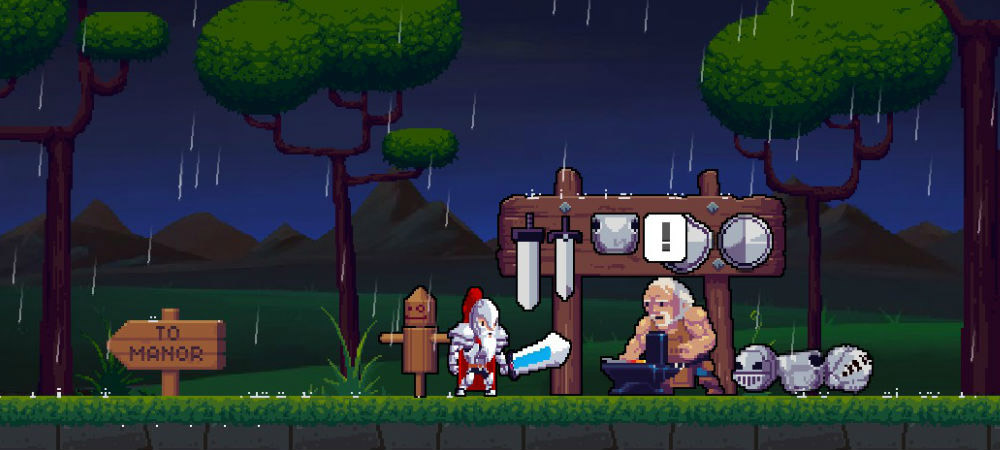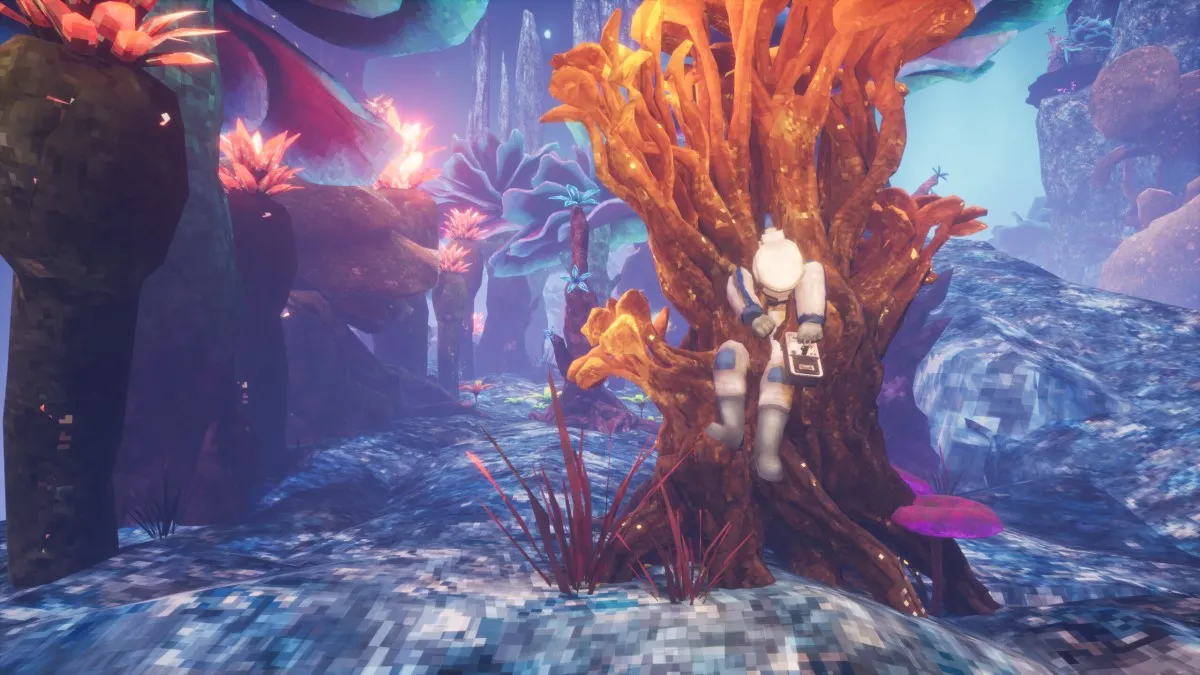En Rogue
Okay, I can do this. I simply need to gather up all my strength and do it. I have plenty of willpower. I just need to sit here long enough to write this review and not start up Rogue Legacy and start playing. Deep breaths. Exhale. Alright, let’s do this.
Rogue Legacy is one of the most addictive games I have played in quite some time. As an action-platformer with roguelike elements, the idea of “one more run” is simply too strong to easily quit at any given time. It also helps that each run will provide a tangible amount of progress, making each run important in the grand scheme of things.
If you lost track of the days playing games like The Binding of Isaac or FTL, clear your schedule for Rogue Legacy.

Rogue Legacy (PC)
Developer: Cellar Door Games
Publisher: Cellar Door Games
Release Date: June 27, 2013
MSRP: $15
Each runthrough of Rogue Legacy‘s randomized dungeon begins with picking one of three randomized characters. Every character has a random class, magic spell, and traits. Classes range from the classic Mage and Barbarian to more nontraditional variations like the Miner, who collects more gold, and the Lich, who gains maximum health with each kill, but starts with very little. Since there is such a limited selection to enter the dungeon, it is crucial for the player to adapt their playstyle to each class; for example, playing a Mage as if it were a Barbarian will result in a swift death.
Each character will also have a spell associated with it. All spells have their pros and cons, and occasionally a specific spell matched with a particular class will create a highly sought after combination or perhaps it will create an abomination that should be avoided at all costs. Only through experimentation will these become obvious, so never write off a combination until you try it for yourself! Traits are small details about the character that, more often than not, have little impact on gameplay. Things like I.B.S. will make the character poot when they jump, and Stereoblindness will cause a Paper Mario-esque flipping animation when turning (since they can’t see in 3D).
These are more like cute quirks than anything gameplay shattering. Some traits, however, can have a much larger impact on gameplay. Dwarfism makes the character about half the size of a normal one, which allows you to get into some secret areas, but reduces the reach of the sword at the same time. Dementia is one of the worst offenders, creating false images of enemies in the dungeon, leaving you to pick out what is real and what is not.
The main objective of Rogue Legacy is to explore the dungeon, slay the four bosses, and eventually, defeat the final boss. The dungeon’s layout is split up into individual rooms and randomized each time, though after a chunk of playtime players will begin to see repeated rooms over and over again. It’s something that comes with the territory; there are only so many rooms to draw from and everyone is bound to see some repeats. It’s a bit distracting when two identical rooms are back-to-back, but this is far from game breaking.
The dungeon is divided into four different sections, each containing a unique environment and a boss fight that can be tackled at any time. There is a definite series of progression between these four, but they can be accessed and tackled whenever you want, as they all branch off from the main Castle area. The game does a great job of directing the player in the correct sequence — through both journal entries found throughout the dungeon as well as ensuring that if a player goes into the incorrect area, they will get their butts kicked. I suppose it is technically possible to beat the entire game with the very first character, though I don’t see that happening any time soon. I would say “never,” but I’ve underestimated people on the internet before.
While these four areas are all very distinct from each other visually, the enemy variation could definitely be better. There are a couple new enemy types introduced in each area, but generally the enemies are just bigger and more powerful versions of previous enemies with slightly different attacks, which comes off as a bit uninspired. Likewise, the boss fights (with the exception of the final boss) are just really big versions of previous enemies but with slight variations to behavior, which is also a bit of a letdown.
There are heaps of secrets to discover within the dungeon walls, and it’s pretty exciting to stumble across them. It really pays to explore as many rooms as possible, but at the same time it is important to have a singular goal based off of the current character. For instance, maybe you’ll develop one of your best/favorite classes with great traits, or maybe you’ll go straight for the boss room and hope you find it quickly. Have a really nimble ability set? Set out to complete Fairy Chest rooms, which provide a piece of equipment or a new ability for completing certain objectives like not taking damage within that room or reaching the chest quickly. It’s important to make goals!

Exploring the dungeon will consist of running, jumping, slashing, and magicking in order to kill enemies and find gold. I should mention that, like with many games of this nature, it’s best to play with a controller. Playing with the keyboard isn’t as bad as it would be for say, Super Meat Boy, but due to the difficulty and platforming elements, a controller is simply better suited for it. Rogue Legacy is a game that is all about control, especially mid-air. Double jumping and air-dashing through various obstacles is not only sometimes necessary to save your life, but also feels super satisfying to pull off.
Death is permanent in Rogue Legacy, which means that each character will have to start from the very beginning in a fresh dungeon. However, despite death being permanent, there is a very sensible sense of progress. While running through the dungeon, players will collect gold by killing enemies, opening chests, and destroying each and every little piece of furniture imaginable. Gold is then used, after dying, to purchase upgrades, equipment, and abilities. Purchasing upgrades via the tech-tree-esque system can improve each character’s base stats like health and strength, unlock new classes, upgrade existing classes with new abilities, and way more.
After finding various pieces of equipment and ability runes in the dungeon, they are then available for purchase. Equipment is rather standard: find, buy, and equip different categories of armor to increase stats. Some of the pieces have extra abilities (like life leech) attached to them, but usually come with a stat penalty to compensate. Abilities consist of things like adding another jump, dashing, returning damage after being hit, or straight up flying for a brief period of time. Five runes can be equipped at once, and equipping multiple of the same rune stacks the effect. In other words, equipping five jump runes will allow the character to jump five times in the air.

Not only does all of this create a wonderful sense of personalization, but the fact that these purchases are permanent is what really sets Rogue Legacy apart from other games with roguelike elements. Normally, any sense of progression comes from simply learning the game’s mechanics and mastering them. While that aspect is still here in spades, there’s also a very obvious and visible sense of progression through all of these upgrades. This allows even the worst of runs to accomplish something, making them feel as if it was all worth it.
Unless you die in the third room. Which I’ve done.
It’s also in the player’s best interest to spend as much money as possible before entering the castle, since a character named Charon sits outside the entrance and will take all your money before you enter. This encourages the player to spend wisely and waste as little as possible, since any money not spent on upgrades will be gone forever. It is seriously one of the most brilliant and simple mechanics I’ve come across. It fits so perfectly within the game, and I just love it.

The pixelated look of the game looks great, and although I wish there were more enemy types, the ones that are there were better designed. Some enemies that would otherwise border on generic are given a personality of their own through look and animation that makes them feel fresh and different.
While there aren’t many music tracks, the ones that the player will hear the most (The Castle music and menu music) are too catchy for their own good. I found myself humming them at all times of the day to myself without even noticing. The sound effects, however, are the best part of the presentation. It’s always a good sign when you can hear something and know exactly what types of enemies are in the room, even before seeing them.
There were a few visual glitches throughout the game that I came across however. Occasionally, room corners will have an extra tile in them that juts out, enemies have spawned in walls, and certain enemy spells have remained on screen after they should have, evidenced by the fact that they no longer did damage when touched. These are all minor issues and, with the exception of the last one, hardly an issue.

Rogue Legacy has built a nest in my brain and will likely live there for quite some time. Even after completing the game once, I feel the need to go back and play through the New Game+ mode. And after that, I will likely go through the New Game+2 mode. This is, to put it simply, an absolute blast to play. The sense of progression, both tangible and intangible, is a very strong driving factor that is layered on top of satisfying gameplay and a whole lot of random.
The visual glitches and lack of enemy variety do little to take away from what is a lovingly crafted game unlike any other I’ve played before. This is a game that won’t just eat up your time, but devour it. If you somehow manage to stop playing after one or two runs, then you are a stronger-willed person than myself. I still feel as if I have a lot to master and can’t wait to do so for months and months to come.





Published: Jun 27, 2013 02:00 pm